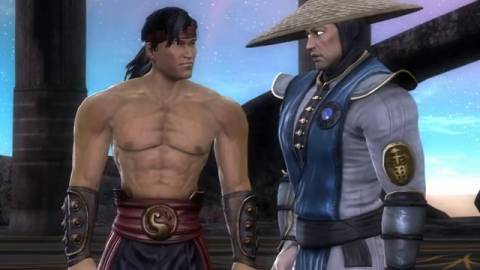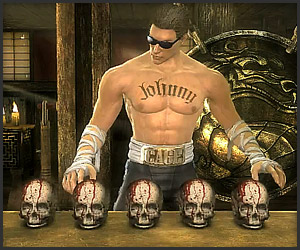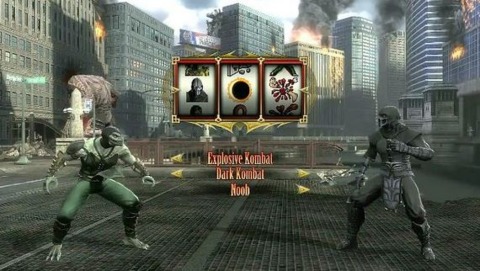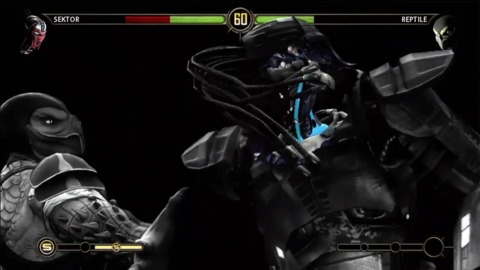
The fighting style in Mortal Kombat builds upon the relatively recent past, with some of its ideas coming out of the previous release, Mortal Kombat vs. DC Universe. But that game was still set in a 3D environment, allowing players to sidestep out of the way of incoming spears, fire, and ice projectiles. The new Mortal Kombat flattens the action back down to a 2D plane, just as it was in the original trilogy of arcade releases. This change makes an immediate impact on the action, returning the game to an in-your-face, offensive style, where the best way to stop your opponent from teleporting behind you with his fist out is often to just do it to him first. Projectiles are truly dangerous again, and the game feels a bit more active than its immediate predecessor did.
The game also returns to the uppercuts and sweeps found in the original trilogy. You can start combos with jump-in punches, juggle them up into the air, and do what you can to keep them there, delivering damage all the while. That's not to say that there's no defensive aspect to Mortal Kombat, as there's definitely value in turtling up, trying to poke, and baiting out someone's X-ray, a bone-crunching move that requires a full super meter to attempt. But at times it feels like the fights are best when two players are simply going for it at all times. It's a thrilling game with a lot of flashy moves and combos, many of which can be sussed out by newer players. The specials are easy to perform, and once you wrap your mind around the logic of getting someone into the air and keeping them there, figuring out the most damaging moves you can is half the fun (at least until someone does the math and tells you which combos, exactly, do the most damage). While it goes out of its way to recall some of the fighting mechanics popularized by MKII and MK3, the game doesn't play like some total throwback, either. Carefully considering when to use the moves that drain parts of your super meter and timing those juggles just right are both pretty key.

Mortal Kombat probably contains the best collection of single-player elements of any fighting game, ever. Its largest piece is the story mode, a chapter-based tale that takes you from one playable character to the next as the events of Mortal Kombat's first three games unfold in an alternate timeline that allows the developers to change some pretty interesting things about the state of the Mortal Kombat universe. By the end, some characters are left in a completely different state than they were in the "normal" timeline, which is pretty cool. But the best part about the story is the way it's conveyed. The game seamlessly weaves from fight to cutscene and back again, loading the battles in the background as you watch the story scenes unfold. Each match even ends with a custom win quote specific to that situation. The flow of the story really sucks you in, and other than having to deal with some annoying boss AI near the end of each tournament (but especially at the very end), it's really outstanding. It's also pretty long, too, with over a dozen chapters that, if I'm counting, probably takes somewhere around seven or eight hours to finish, provided you aren't skipping cutscenes. In addition to the preset story mode, you can also take on an arcade ladder mode with each character, which gives you a quick batch of fights that culminate in character-specific endings.
The other big single-player mode is the Challenge Tower, which is a collection of 300 tasks that vary up the rules of the fighting in a lot of different ways. Some are simple changes, like tag battles where the tagged out partner recovers health, or fights that must be finished with a fatality in order to be completed, or endurance battles that have you outnumbered. But some of them get way crazier, like one where instead of using normal attacks, each button press launches one of your limbs at your enemy. The limbs grow back over time, giving you a steady stream of heads, arms, and legs to launch. Others have the whole world tilt from side to side as hits land, with the fighter on the "low" side of the screen taking steady damage. There are a lot of inventive twists on the standard MK fight in the Tower, though a few types repeat a little too frequently as you rise to the final battle. Some of the tasks even come with a bit of dialogue, some of which gets pretty silly, such as one that has Mileena trying to give a teddy bear as a gift, or another that has Shang Tsung and Shao Kahn fighting over a gurgling baby that sits in the background as you battle. It really keeps you guessing in the same way that Soul Calibur's similar Mission Mode did.

Online, the game plays mostly how it plays offline, provided the network conditions are just right. The structure of the online mode starts with the same sort of lobby system used in Mortal Kombat vs. DC Universe, giving players a spot to swap text with one-another as challenges are passed around and battles are fought. If you don't want to mess around with chat rooms, the standard ranked and unranked options are also present. Both regular and tag battles can be played online, and a new mode called King of the Hill rounds things out pretty nicely. This is MK's take on the "quarter match" or "endless battle" mode, allowing up to eight players to join a room and spectate fights while they wait for their turn to take on the current winner. The loser of each fight goes to the back of the line. MK's take on the mode includes a visual lobby, of sorts, where avatars stand around and watch the battles. You can emote with your avatar using different button presses to express your joy or rage during a fight, or you can just hit the select button and make the fight take up the entire screen. After a fight, the spectators and the loser are asked to rate the match, which gives "respect points" to the winner. The avatar presentation is a cool way to present the concept, and there are even hidden emotes in there for players to figure out, proving that the team behind Mortal Kombat will stuff secret moves into just about anything they possibly can.

Though the look and feel of the game is roughly identical across platforms, the PlayStation 3 version of Mortal Kombat offers some additional features that make it the better version of the two. Specifically, the PS3 version has support for 3D televisions and also has an additional character, Kratos from God of War. The extra character and stage are nice, and Kratos has a pretty cool ending, but it probably isn't a make-or-break addition unless you're a huge fan of the God of War series. The game's 3D mode looks quite nice. I certainly found it easier to follow than the typical 3D first-person shooter, though that says more about the differences in presentation between the two genres than anything about the quality of any one game's 3D support.
Mortal Kombat has a broad appeal that I think will work for players from a variety of skill levels. There's a passable tutorial in place to teach you the basics, but no one thing in the game is that tough to accomplish. The game gets tricky when you start to put all of those things together into combos, but by the time you're thinking about that, you'll probably be ready to handle it. As for top-level play, I'm not the guy to judge any fighting game from the "is this game tournament-worthy?" angle. But MK feels solid, with enough depth and guessing games in place to work, provided that it's as balanced as it feels after a week of solid play. But even if, for some reason, the competitive aspects of the game didn't work out, there's so much great single-player material in Mortal Kombat that it's still worthwhile even if you aren't looking to fight others.